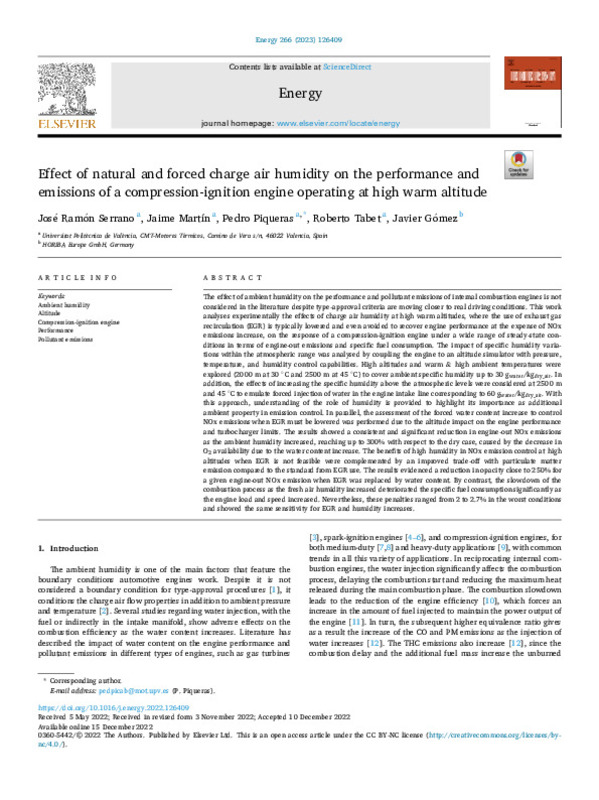JavaScript is disabled for your browser. Some features of this site may not work without it.
Buscar en RiuNet
Listar
Mi cuenta
Estadísticas
Ayuda RiuNet
Admin. UPV
Effect of natural and forced charge air humidity on the performance and emissions of a compression-ignition engine operating at high warm altitude
Mostrar el registro sencillo del ítem
Ficheros en el ítem
| dc.contributor.author | Serrano, J.R.
|
es_ES |
| dc.contributor.author | Martín, Jaime
|
es_ES |
| dc.contributor.author | Piqueras, P.
|
es_ES |
| dc.contributor.author | Tabet-Aleixandre, Roberto
|
es_ES |
| dc.contributor.author | Gómez-Gil, Javier
|
es_ES |
| dc.date.accessioned | 2024-01-05T19:02:18Z | |
| dc.date.available | 2024-01-05T19:02:18Z | |
| dc.date.issued | 2023-03-01 | es_ES |
| dc.identifier.issn | 0360-5442 | es_ES |
| dc.identifier.uri | http://hdl.handle.net/10251/201547 | |
| dc.description.abstract | [EN] The effect of ambient humidity on the performance and pollutant emissions of internal combustion engines is not considered in the literature despite type-approval criteria are moving closer to real driving conditions. This work analyses experimentally the effects of charge air humidity at high warm altitudes, where the use of exhaust gas recirculation (EGR) is typically lowered and even avoided to recover engine performance at the expense of NOx emissions increase, on the response of a compression-ignition engine under a wide range of steady-state con-ditions in terms of engine-out emissions and specific fuel consumption. The impact of specific humidity varia-tions within the atmospheric range was analysed by coupling the engine to an altitude simulator with pressure, temperature, and humidity control capabilities. High altitudes and warm & high ambient temperatures were explored (2000 m at 30 degrees C and 2500 m at 45 degrees C) to cover ambient specific humidity up to 30 gwater/kgdry_air. In addition, the effects of increasing the specific humidity above the atmospheric levels were considered at 2500 m and 45 degrees C to emulate forced injection of water in the engine intake line corresponding to 60 gwater/kgdry_air. With this approach, understanding of the role of humidity is provided to highlight its importance as additional ambient property in emission control. In parallel, the assessment of the forced water content increase to control NOx emissions when EGR must be lowered was performed due to the altitude impact on the engine performance and turbocharger limits. The results showed a consistent and significant reduction in engine-out NOx emissions as the ambient humidity increased, reaching up to 300% with respect to the dry case, caused by the decrease in O2 availability due to the water content increase. The benefits of high humidity in NOx emission control at high altitudes when EGR is not feasible were complemented by an improved trade-off with particulate matter emission compared to the standard from EGR use. The results evidenced a reduction in opacity close to 250% for a given engine-out NOx emission when EGR was replaced by water content. By contrast, the slowdown of the combustion process as the fresh air humidity increased deteriorated the specific fuel consumption significantly as the engine load and speed increased. Nevertheless, these penalties ranged from 2 to 2.7% in the worst conditions and showed the same sensitivity for EGR and humidity increases. | es_ES |
| dc.description.sponsorship | This research has been supported by Grant PID2020-114289RB-I00 funded by the Spanish Ministerio de Ciencia e Innovacion - Agencia Estatal de Investigacion (MCIN/AEI/10.13039/501100011033). The PhD candidate Roberto Tabet has been funded by Universitat Politecnica de Valencia through grant PAID -01-18. | es_ES |
| dc.language | Inglés | es_ES |
| dc.publisher | Elsevier | es_ES |
| dc.relation.ispartof | Energy | es_ES |
| dc.rights | CC BY-NC | es_ES |
| dc.subject | Ambient humidity | es_ES |
| dc.subject | Altitude,Compression -ignition engine | es_ES |
| dc.subject | Performance | es_ES |
| dc.subject | Pollutant emissions | es_ES |
| dc.subject.classification | MAQUINAS Y MOTORES TERMICOS | es_ES |
| dc.title | Effect of natural and forced charge air humidity on the performance and emissions of a compression-ignition engine operating at high warm altitude | es_ES |
| dc.type | Artículo | es_ES |
| dc.identifier.doi | 10.1016/j.energy.2022.126409 | es_ES |
| dc.relation.projectID | info:eu-repo/grantAgreement/AEI/Plan Estatal de Investigación Científica y Técnica y de Innovación 2017-2020/PID2020-114289RB-I00/ES/INTEGRACION DE SISTEMAS DE POST-TRATAMIENTO DE GASES DE ESCAPE MULTIFUNCIONALES EN VEHICULOS DE PROPULSION HIBRIDA/ | es_ES |
| dc.relation.projectID | info:eu-repo/grantAgreement/UPV//PAID-01-18//Programa de Ayudas de Investigación y Desarrollo (PAID-01-18)/ | es_ES |
| dc.rights.accessRights | Abierto | es_ES |
| dc.contributor.affiliation | Universitat Politècnica de València. Escuela Técnica Superior de Ingenieros Industriales - Escola Tècnica Superior d'Enginyers Industrials | es_ES |
| dc.contributor.affiliation | Universitat Politècnica de València. Escuela Técnica Superior de Ingeniería del Diseño - Escola Tècnica Superior d'Enginyeria del Disseny | es_ES |
| dc.description.bibliographicCitation | Serrano, J.; Martín, J.; Piqueras, P.; Tabet-Aleixandre, R.; Gómez-Gil, J. (2023). Effect of natural and forced charge air humidity on the performance and emissions of a compression-ignition engine operating at high warm altitude. Energy. 266:1-11. https://doi.org/10.1016/j.energy.2022.126409 | es_ES |
| dc.description.accrualMethod | S | es_ES |
| dc.relation.publisherversion | https://doi.org/10.1016/j.energy.2022.126409 | es_ES |
| dc.description.upvformatpinicio | 1 | es_ES |
| dc.description.upvformatpfin | 11 | es_ES |
| dc.type.version | info:eu-repo/semantics/publishedVersion | es_ES |
| dc.description.volume | 266 | es_ES |
| dc.relation.pasarela | S\483566 | es_ES |
| dc.contributor.funder | AGENCIA ESTATAL DE INVESTIGACION | es_ES |
| dc.contributor.funder | Universitat Politècnica de València | es_ES |
| dc.subject.ods | 07.- Asegurar el acceso a energías asequibles, fiables, sostenibles y modernas para todos | es_ES |








